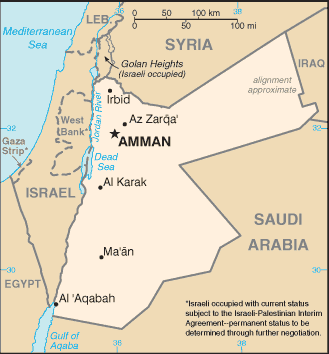Hashemite Kingdom of Jordan
Related Categories:
 Jordan - Fotw
Jordan - FotwThe flag symbolizes the Kingdom's roots in the Great Arab Revolt of 1916.
www.fotw.us/
History, politics, geography, economy.
en.wikipedia.org/
The land that became Jordan is part of the richly historical Fertile Crescent region. Around 2000 B.C., Semitic Amorites settled around the Jordan River in the area called Canaan. Subsequent invaders and settlers included Hittites, Egyptians, Israelites, Assyrians, Babylonians, Persians, Greeks, Romans, Arab Muslims, Christian Crusaders, Mameluks, Ottoman Turks, and, finally, the British. At the end of World War I, the League of Nations awarded the territory now comprising Israel, Jordan, the West Bank, Gaza, and Jerusalem to the United Kingdom as the mandate for Palestine and Transjordan. In 1922, the British divided the mandate by establishing the semiautonomous Emirate of Transjordan, ruled by the Hashemite Prince Abdullah, while continuing the administration of Palestine under a British High Commissioner. The mandate over Transjordan ended on May 22, 1946; on May 25, the country became the independent Hashemite Kingdom of Transjordan. It ended its special defense treaty relationship with the United Kingdom in 1957.
Transjordan was one of the Arab states which moved to assist Palestinian nationalists opposed to the creation of Israel in May 1948, and took part in the warfare between the Arab states and the newly founded State of Israel. The armistice agreements of April 3, 1949 left Jordan in control of the West Bank and provided that the armistice demarcation lines were without prejudice to future territorial settlements or boundary lines.
In 1950, the country was renamed the Hashemite Kingdom of Jordan to include those portions of Palestine annexed by King Abdullah I. While recognizing Jordanian administration over the West Bank, the United States maintained the position that ultimate sovereignty was subject to future agreement.
Jordan signed a mutual defense pact in May 1967 with Egypt, and it participated in the June 1967 war between Israel and the Arab states of Syria, Egypt, and Iraq. During the war, Israel gained control of the West Bank and all of Jerusalem. In 1988, Jordan renounced all claims to the West Bank but retained an administrative role pending a final settlement, and its 1994 treaty with Israel allowed for a continuing Jordanian role in Muslim holy places in Jerusalem. The U.S. Government considers the West Bank to be territory occupied by Israel and believes that its final status should be determined through direct negotiations among the parties concerned on the basis of UN Security Council Resolutions 242 and 338.
The 1967 war led to a dramatic increase in the number of Palestinians living in Jordan. Its Palestinian refugee population--700,000 in 1966--grew by another 300,000 from the West Bank. The period following the 1967 war saw an upsurge in the power and importance of Palestinian resistance elements (fedayeen) in Jordan. The heavily armed fedayeen constituted a growing threat to the sovereignty and security of the Hashemite state, and open fighting erupted in June 1970.
No fighting occurred along the 1967 Jordan River cease-fire line during the October 1973 Arab-Israeli war, but Jordan sent a brigade to Syria to fight Israeli units on Syrian territory. Jordan did not participate in the Gulf war of 1990-91. In 1991, Jordan agreed, along with Syria, Lebanon, and Palestinian representatives, to participate in direct peace negotiations with Israel sponsored by the U.S. and Russia. It negotiated an end to hostilities with Israel and signed a peace treaty in 1994. Jordan has since sought to remain at peace with all of its neighbors.
www.state.gov/r/
Introduction
About
Contact
Symbols in The News
Interpret this Symbol
AAC
African
AI
Alchemy
Alphabets
Ancient
Animal Symbolism
Architecture
Art
Articles
Astrology
Baha'i
Blissymbolics
Blueprint Symbols
Buddhist
Celtic Symbols
Cemetery
Chinese Symbols
Christian
Circle
City
Codes
Color
Conlangs
Crop Circles
Danger
Da Vinci Code
Designing Logos
Dictionaries
Dreams
Education
Egyptian Symbols
Electrical
Emoticons
Find Images
Fonts
Food
Fraternity
Hamsa
Healing
Heraldry
Hermetic
Highway Signs
Hindu
History
Hobo
Holiday
Icons
iConji
Islamic
Jain Symbols
Japanese, Kanji
Jewish
Justice
Law
Literary Symbolism
Mandalas
Map
Masonic
Math, Number
Meaning of Names
Medical
Middle East
Military
Miscellaneous
Money
Music
Mythology
Native American
Playing Cards
Power
Psychology
QiQiiKhu
Reiki
Religious
Runes, Norse
Sacred Geometry
Scientific
Science Fiction
Sorority
Sports
Symbols in the News
Tattoos
ThirteenSymbols
Tree of Life
Ursprache
Videos
Visual Languages
Weather
Web Codes
Wicca
Words
Writing Systems
Braille
Coinherence
Coptic
Cuneiform
Easter Island
Etruscan
Happy Human
Hebrew
Kokopelli
Linear B
Lotus
Love Symbols
Mandorla
Moon Alphabet
Nine Pointed Star
Om
Oz
Phonetic
Scarab Beetle
Silent
Theosophy
Unifon
About
Contact
Symbols in The News
Interpret this Symbol
AAC
African
AI
Alchemy
Alphabets
Ancient
Animal Symbolism
Architecture
Art
Articles
Astrology
Baha'i
Blissymbolics
Blueprint Symbols
Buddhist
Celtic Symbols
Cemetery
Chinese Symbols
Christian
Circle
City
Codes
Color
Conlangs
Crop Circles
Danger
Da Vinci Code
Designing Logos
Dictionaries
Dreams
Education
Egyptian Symbols
Electrical
Emoticons
Find Images
Fonts
Food
Fraternity
Hamsa
Healing
Heraldry
Hermetic
Highway Signs
Hindu
History
Hobo
Holiday
Icons
iConji
Islamic
Jain Symbols
Japanese, Kanji
Jewish
Justice
Law
Literary Symbolism
Mandalas
Map
Masonic
Math, Number
Meaning of Names
Medical
Middle East
Military
Miscellaneous
Money
Music
Mythology
Native American
Playing Cards
Power
Psychology
QiQiiKhu
Reiki
Religious
Runes, Norse
Sacred Geometry
Scientific
Science Fiction
Sorority
Sports
Symbols in the News
Tattoos
ThirteenSymbols
Tree of Life
Ursprache
Videos
Visual Languages
Weather
Web Codes
Wicca
Words
Writing Systems
Braille
Coinherence
Coptic
Cuneiform
Easter Island
Etruscan
Happy Human
Hebrew
Kokopelli
Linear B
Lotus
Love Symbols
Mandorla
Moon Alphabet
Nine Pointed Star
Om
Oz
Phonetic
Scarab Beetle
Silent
Theosophy
Unifon

